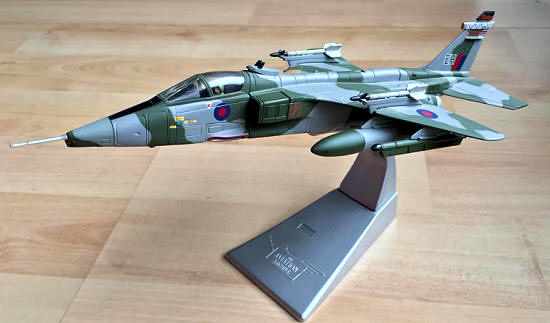 The Initial Image
The Initial Image
Slipping the Bonds
by George Paterson
Jaguar GR1A-6sq. RAF
Introduction
The SEPECAT Jaguar is a close support and nuclear strike aircraft developed jointly by France (Breguet) and Britain (BAC). Development started in the early 1960's, initially as a sub-sonic trainer, but it soon acquired more powerful engines with re-heat, and more advanced electronics focussed on the attack role. This process of upgrading the capabilities of the aircraft led to a divergence between the British and French versions, the British favouring a high degree of sophistication, and the French preferring to keep things simple and less costly.
 The Initial Image
The Initial Image
This is a die-cast model by Corgi, and is of the RAF version flown by 6.Squadron; it carries the squadron badge in red just aft of the engine intakes, and the squadron décor, (a red zig-zag on a blue background) on the housing near the top of the fin.
Treatment of the Image
The basic shape of the airframe is very accurate, and the definition is very even over the whole airframe; it is easy to clarify the minor details that require treatment.
In practice, quite a lot of amendment was necessary. I started on the front fuselage, adding some details, removing details that relate to the moulding process, etc. My objective was to modify the image to portray the aircraft as it would appear with no hint of its die-cast origin.
I was particularly careful with the many décor elements – the only one I left
untouched was the roundel on the port wing.
was particularly careful with the many décor elements – the only one I left
untouched was the roundel on the port wing.
The housing that sits on top of the spine just aft of the cockpit seemed to me to stand a little too prominent, and so I reduced its hight by about a quarter.
The primary role of the Jaguar was low-level strike, so I pasted the finished airframe onto a low-altitude background, with a few wisps of low cloud partly concealing the landscape below.
Conclusions
Considering that the Jaguar gave both Britain and France a credible high-performance nuclear strike capability for a period of about 25 years, it was extremely good value for money; It was a small but potent aircraft, and it's not surprising that the Indian air force has recently been acquiring more of them. One way or another, Jaguars are likely to be in service for some years to come.